Sometimes, after buying and settling a new plant in the aquarium, aquarists find small snails with a beautiful spiral-wound shell. Many leave these new tenants, not realizing that under certain conditions they can increase their numbers unusually quickly. We are talking, of course, about the coils – the famous aquarium snails. Are these creatures helpful? Or should you get rid of them as soon as possible? You will find the answers to these questions in our article.
General information
Coils (Planorbidae) are a family of freshwater gastropods that are widespread on almost all continents. Some species are frequent inhabitants of home aquariums, arriving here mostly randomly (eggs or young snails are usually brought in on plants). Although some aquarists start them on purpose for the sake of variety or to feed some species of fish.
Coils are unusually hardy mollusks, they can exist in various water parameters, and multiply easily and quickly. These invertebrates can breathe in two ways – using oxygen dissolved in water and atmospheric air.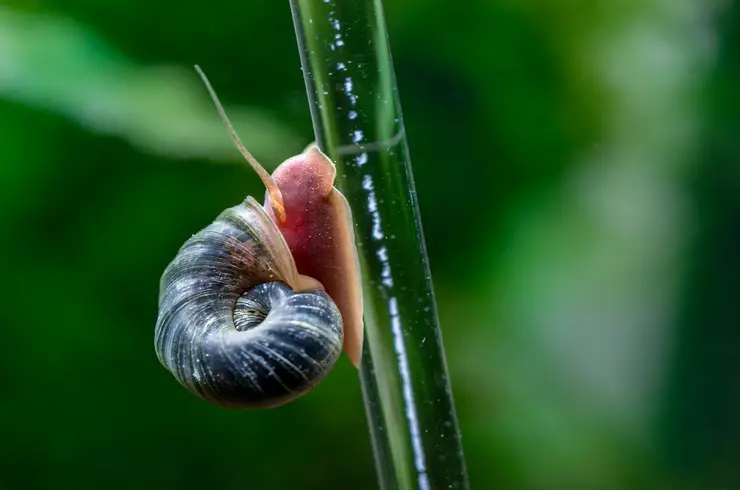
An interesting feature of the coils is the ability to move the sink down on the surface of the water. The air that snails draw into the shell when breathing helps to maintain balance. The support is the surface tension of the water or the bacterial film. True, if you even slightly touch the snail at this time, it will instantly begin to sink. This allows them to escape from predators.
Coils can multiply very quickly, but this happens mainly in conditions of excess food when the aquarist regularly overfeeds the fish.
The positive point in the content of the coils is that these mollusks do not spoil the plants, but the dead leaves are processed with a bang, being typical detritophages.
It is not recommended to bring coils from natural reservoirs into the aquarium. Gastropods are intermediate hosts for many types of parasites that are dangerous to fish.
Appearance
The coils got their name for their characteristic shell, which resembles a tightly wound spiral. The number of turns varies from 4 to 8. Seams between the turns are clearly visible, each of which is thicker than the previous one.
The largest species can reach 3.5 cm in size, although most snails barely step over the one-centimeter bar.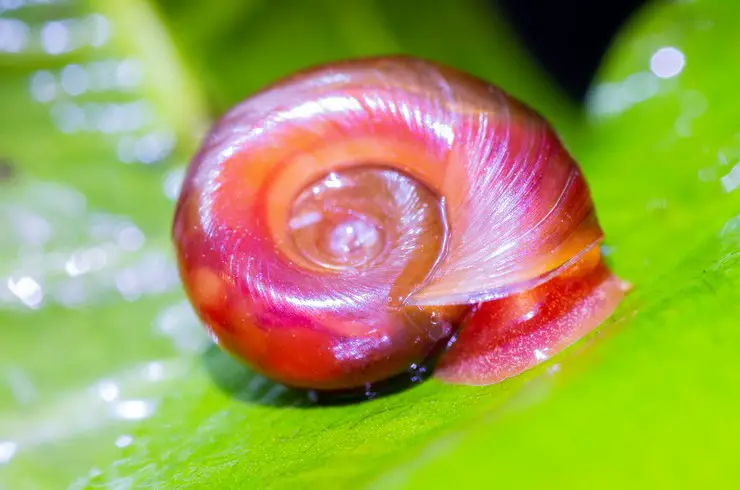
The shell usually ranges in color from brown to bright red. The leg is flat and wide. With the help of it, the snails move slowly over the substrate. Long antennae are located on the head, at the base of which are the organs of vision.
Habitat
Coils are a cosmopolitan family that can be found almost everywhere. A typical biotope is a reservoir with a weak current and dense thickets of aquatic plants. Mollusks live in shallow water in a litter of rotting organic matter at the bottom. You can meet snails even in very polluted rivers with low oxygen content. Pulmonary respiration helps them survive in such conditions.
Aquariums are usually home to thermophilic tropical snail species.
Care and maintenance
It will not be difficult to create comfortable conditions for the reels. An aquarium with a volume of one liter or more will do. Do not forget to cover it with a lid to prevent the coils from escaping disastrously for them.
Snail primer is optional, so you can use whatever you like. But it is worth planting more live plants – the coils will not touch them, and the benefits of plants in the aquarium are invaluable.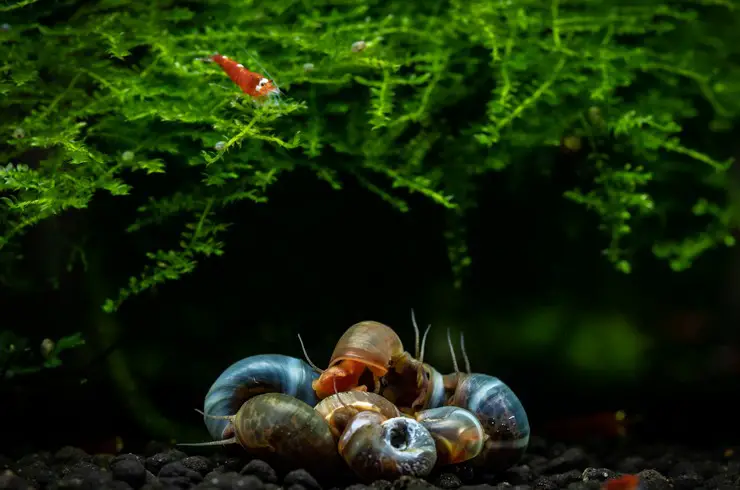
When using the filter, try to keep the water flow to a minimum.
The coils are able to live well in a wide range of water parameters, and when adverse conditions occur, they often hibernate. The optimum temperature will be 22-28 ° C. Other parameters do not play a special role in the life of these mollusks.
It is important to regularly monitor the condition of the snails. This is due to the fact that dead shellfish can quickly spoil the water in the aquarium.
Compatibility
Coils are completely harmless mollusks, they can be kept with any calm species of fish, for example, zebrafish, neons, tetras, guppies. Ancistrus catfish get along well with adult snails, but the eggs of the coils can be destroyed.
Care must be taken to the cohabitation of coils and aggressive labyrinths (cockerels, macropods). These species pose a danger to young soft-shelled snails. On the other hand, it allows for a natural adjustment of the number of coils.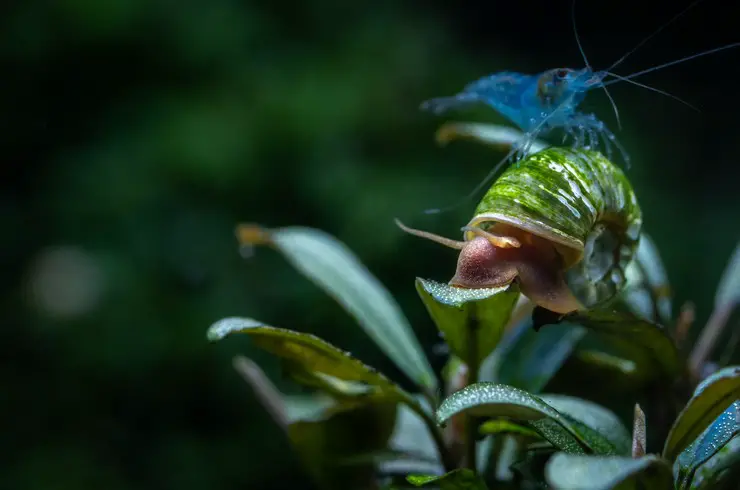
Snails are completely incompatible with fish such as bocci or tetraogons. Mollusks must be included in the diet of the latter, therefore they are often grown as food organisms for these fish. The coils have a “soft” shell compared to other types of snails and are easily eaten by fish.
Coil snail feeding
Like any detritus feeder, the coils feed on decaying organic matter and algae, so finding food in an aquarium for them will not be difficult for them. No additional feeding is required for shellfish, but any fish food that has fallen to the bottom (such as TetraMin) will be eaten with pleasure.
Do not rush to get angry with the reel if you find it on a dead fish. The death of the fish was caused by other reasons, and the snail just crawled to eat.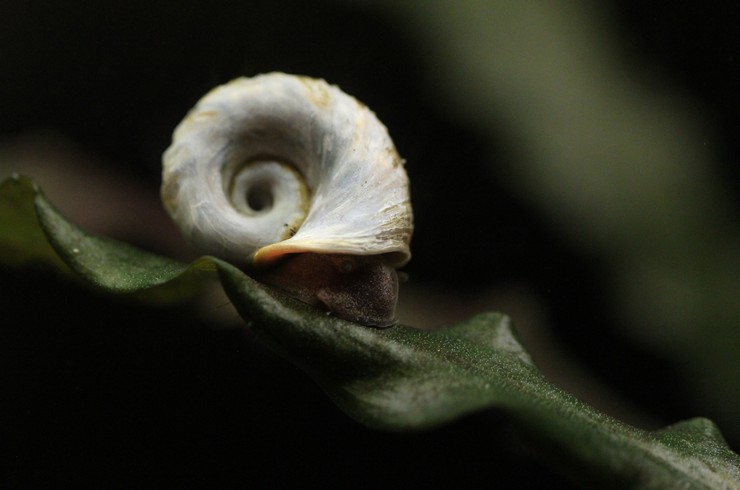
Reproduction and breeding
Coil snails are typical hermaphrodites, meaning each of them has both female and male gender glands. For fertilization, only two individuals are enough, which cross-exchange gender products.
The snail then lays its eggs on the underside of the plant’s leaves. They look like white dots in a gelatinous cocoon. This cocoon is strong enough and can withstand the onslaught of some fish species.
Depending on the water temperature, eggs incubation lasts from 14 to 30 days, after which small snails are born. Their shell is soft, so they can easily become a victim of almost any fish.
Snails reproduce and develop especially actively in aquariums with warm water 25-28 ° C and regular overfeeding of fish. A sharp increase in the snail population is a signal to limit fish feeding.
